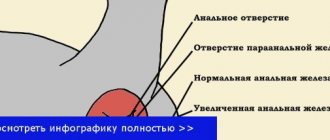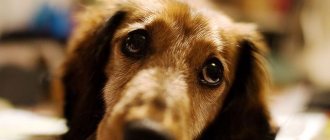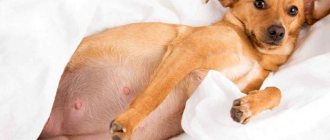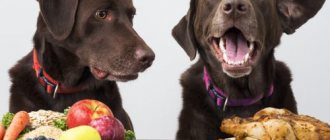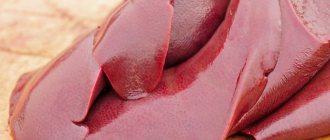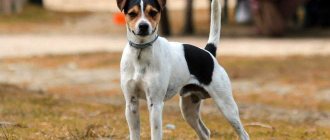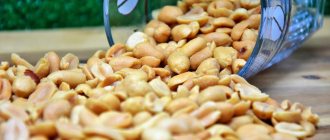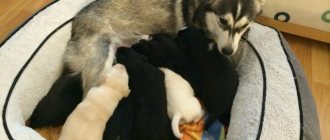Recently, more and more often there has been a tendency for dog breeders to begin to more carefully monitor the health of their pet. Regular brushing of teeth, ears, nail trimming and eye rinsing.
But unfortunately, many dog owners do not pay attention to other, equally important parts of the animal’s body. I'm talking about the anal glands in dogs. This part of the body needs to be looked after just like any other.
Let's talk today about what the paraanal glands are in dogs, why problems arise with them, and how you can clean them yourself.
What are paraanal glands
The anal glands in dogs are small sacs that are located inside the anus, just before it exits. Inside these bags, a special secret constantly accumulates, allowing dogs to differ from each other by their individual scent.
During normal emptying, feces, passing through the anus, press on these sacs, and the secretion from the sacs, along with the feces, comes out.
Thus, most dogs naturally cleanse their bodies themselves, and the owners do not even suspect the presence of any glands there. But only until you have to face this problem yourself.
Factors
The accumulation of secretions in domestic dogs can be caused by:
- A hereditary factor that manifests itself in small breeds that are prone to obesity (this often occurs in pugs, dachshunds and bulldogs);
- The sedentary lifestyle of dogs leads to difficulty in releasing secretions;
- Eating a pet from a common table leads to this problem;
- Often, at a veterinarian's appointment, examination of the anus is ignored and, as a result, the animal owner may not be aware of the accumulation of discharge.
Preventive measures to prevent stagnation are two active walks a day. Sometimes the anal area should be washed and massaged.
What causes blockage of the anal glands?
Blockage of the paraanal glands occurs because the secretion accumulates in the glands for a long time and does not come out. Problems with the anal glands are a direct consequence of problems with excretion of feces from the animal’s body.
These problems may be caused by:
- Sedentary lifestyle (the animal moves so little that problems arise not only with excretion, but also with the formation of feces).
- Poor nutrition (frequent constipation or diarrhea leads to the fact that when passing through the anus, feces have such a heterogeneous consistency that they simply do not squeeze out the secretion from the paraanal glands).
- Incorrect daily routine (the animal endures a lot and, as a result, secretions accumulate in the glands and blockage occurs).
Operation
Normally, the produced secretions come out unhindered. This occurs in a dog during the act of defecation. Feces slightly compress the glands, helping them release their contents.
Animals that live outside almost never have problems with stagnation of characteristic secretions, leading to obstruction of the canals. If your pet is fed properly and walked on time, no help will be required. The body can cope with cleansing itself without auxiliary actions.
How to Determine When It's Time for Your Pet to Have Anal Glands Cleaned
If the secretion accumulates in the gland for a long time, then the animal begins to experience discomfort in a certain area. The dog tries to squeeze out the contents of the bags on its own. At such moments, the pet begins to behave as its natural instincts tell it.
If the anal glands in dogs are clogged, the animal begins to behave as follows:
- Rubs her butt on the floor, especially on its fleecy surfaces. In such cases, many pet owners begin to think that their pet has worms. But they could be wrong.
- If friction on the floor fails to squeeze out the secretion, the dog tries to chew under its tail. The animal may suddenly jump up, twist towards its tail, trying to catch an invisible enemy. Sometimes it comes to the point that the animal chews out the fur under its tail.
- An unpleasant, previously unusual odor appears from the anus.
If you notice all these symptoms in your pet, then most likely he needs cleaning of the anal glands. If you are a squeamish person, or are afraid of harming your pet, then, of course, it is better to go to a veterinary clinic.
But in fact, if there is no inflammation in the anal area, and if the dog does not experience pain when pressed, then you can clean your pet’s anal glands yourself. Cleaning the glands, although not the most pleasant procedure, is quite simple.
Characteristic symptoms
Undetected stagnation of secretions in time leads to inflammation of the organ. This can be understood by the following manifestations:
- The animal rubs against the floor on an uneven surface;
- Vigorously chews on the hind legs and tail, trying to reach the anus;
- The anal area becomes swollen and red;
- The tail and the area near its base suffers from hair loss.
All these signs may indicate the necessary cleaning of the glands and contact a specialist.
The accumulated secretions can damage the wall of the gland and form an ulcer in the anus. In this state, the dog refuses to eat, becomes lethargic and sleeps a lot. Purulent discharge is constantly released from the ulcerative formation; urgent veterinary attention is required.
How to clean your dog's anal glands yourself
Before you begin the cleaning procedure, you must make sure that your dog has a problem with the anal glands.
To do this, you need to palpate the anus from the inside. It is best to carry out this procedure with gloves. Insert your index finger shallowly into the hole (almost at the very exit) and gently begin probing. If there are no seals, the bags are soft and practically cannot be felt, then you can be sure that everything is in order. If the dog’s paraanal glands are clogged, then even with light pressure you will immediately feel a compaction.
If you find seals, then you can safely begin the cleaning procedure.
What you will need
Prepare:
- Gloves.
- Paper napkin or clean rag.
- Basin.
- Petrolatum.
How to clean a dog's anal glands
There are two ways to clean the anal glands in dogs.
Method one
Do the following:
- Place your pet in the bathtub. If the dog is small, then you can use a simple basin.
- Ask someone from your household to hold the four-legged animal by the muzzle and body so that it does not spin or struggle.
- Put on gloves and feel the glands from the outside.
- Next, take the dog by the base of the tail and lift the tail up as far as possible, but so as not to cause pain to the animal.
- With another gloved hand or just using a napkin, use your thumb and forefinger to apply pressure to the area on the sides of the anus. If you did everything correctly, a viscous, unpleasant-smelling beige liquid should come out of the bags.
- After this, rinse everything thoroughly with water.
If after this procedure there is no result, and the paraanal glands are not freed from secretion, then under no circumstances press with double force. In this case, it is better to contact a veterinary clinic. It is possible that the glands are so clogged that home cleaning will not help and surgery will be required to remove the sacs.
Method two
Try this:
- Place your pet in the tub or basin and have someone help hold the animal.
- Wear gloves.
- Lubricate the index finger of your right hand (on top of your gloves) with Vaseline.
- With your left hand, in the same way as I described in the first method, lift the dog’s tail as much as possible.
- Carefully insert your index finger, lubricated with Vaseline, into the animal's anus. The palm should be in a position perpendicular to the floor.
- Using the index finger of your right hand, gently feel the gland.
- Next, use the index finger of your right hand (inside the anus) and the thumb of the same hand (outside the anus) to press the pouch, squeezing the secretion out.
- Rinse everything off with water.
It goes without saying that this procedure will not give your pet any pleasure. Therefore, together with your assistant, act harmoniously. The assistant must hold the four-legged firmly (but not painfully) so that he does not escape. Talk to the animal, calm it down, praise it.
As a rule, such cleaning lasts for a maximum of six months. But if you regularly carry out preventive measures, then it is quite possible that in the future you will not need to do such a procedure at all.
Abscess
Everyone knows: if there is no special hole for removing fluid, then if the gland is full, it will find a place to exit. The wall breaks through and the secretion flows out. An abscess is a small hole through which a yellowish liquid constantly oozes. Neighboring tissues begin to become inflamed and painful, the dog often licks the affected area, bacteria enter the wound and multiply vigorously.
This leads to a sharp deterioration in the animal’s well-being, it becomes lethargic, and the temperature rises. You urgently need to run to the veterinarian, he will show you how to clean the glands so that this does not happen again, remove all the pus and treat the wound. If necessary, drainage is installed and suppositories are prescribed, for example, Proctosedyl. In difficult cases, a course of antibiotics is indicated to suppress the growth and reproduction of bacteria.
Prevention of blockage of the paraanal glands
So that you don’t have to find out what paraanal glands are in dogs and avoid problems with their treatment, you just need to follow the following preventive measures:
- Walk your pet more often. The less often the dog goes to the toilet, the less often the secretion is removed from the anal glands.
- Walks should be active. A sedentary lifestyle contributes to constipation and inflammation of the glands.
- Monitor the four-legged diet. It is important that the stool is well formed. This will eliminate constipation or diarrhea, which increases the risk of blockage and inflammation of the anal glands. An excess of protein foods and carbohydrates very often leads to constipation. The four-legged diet must contain fiber, which improves digestion. You can read here how to balance a dog’s diet, which foods must be present in the diet when feeding them naturally, and which should absolutely be excluded.
- Carry out hygiene procedures regularly, not forgetting to check the condition of the glands. For young animals, such a check should be carried out once a year. Elderly animals need to check the condition of their glands more often – once every six months.
Stages
Inflammation develops in stages, causing increasingly obvious signs of pathology:
- Natural outflow is disrupted;
- A lot of secretory fluid accumulates;
- Gradually the consistency of the secretion thickens;
- The tissues of the pouches become inflamed, causing discomfort and pain;
- The affected surface becomes an excellent environment for the activity of pathogenic microorganisms;
- Due to secondary microflora, the inflammatory process intensifies, leading to the formation of purulent exudate and abscess;
- When abscesses rupture, fistulas form.
These changes are accompanied by other pathological phenomena, and the owner should pay attention to the pet’s condition as early as possible.
Consequences of blockage of the anal glands
Inflammation
Inflammation of the paraanal glands occurs because the secretion accumulates inside the paraanal sacs for a long time. Having no way out, the secret begins to rot.
Characteristic signs of inflammation of the glands are: redness, rash, swelling and irritation near the anus. The fur around the hole gets wet and falls out. The dog begins to behave restlessly. She constantly rolls her butt on the floor, trying to relieve the itching and pain, gnawing under her tail.
If a dog’s paraanal glands are inflamed, then in this case there is no need to resort to self-cleaning. It is better to contact a veterinary clinic. The veterinarian will clean the inflamed glands, treat the skin and prescribe further treatment. If the owner of the animal is a careless person and does not pay any attention to the appearance of inflammation in the anal area, then irreparable consequences may occur.
Abscess
This process can be compared to a balloon bursting. The liquid inside the anal sac accumulates and accumulates and, not finding a way out, breaks through the walls of the sac.
Characteristic symptoms of an abscess: ulcers, swelling and redness around the anus. Constantly oozing foul-smelling liquid from it, dampening of the fur. The animal becomes lethargic, refuses food and water, and the temperature rises. In this case, you need to immediately run to the veterinarian, because there are often cases when abscesses lead to death.
Treatment of complications
If the doctor has diagnosed an abscess or fistula in a dog, then the treatment should be comprehensive.
An abscess involves treatment in several stages:
- If the abscess does not have time to open on its own, the doctor may prescribe the use of compresses and, after a few days, open the suppuration on its own;
- Getting rid of pus and cleaning the paraanal gland under the tail;
- Antiseptic wound treatment;
- The use of suppositories, injections, tablets and preparations for local treatment of wounds;
- Use of antibiotics;
- Following recommendations to improve the animal’s diet, adding additional vegetables to the menu to improve intestinal function;
- In the most advanced cases, removal of the anal glands is indicated.
If a fistula is discovered in a pet, this is a reason to contact a veterinarian urgently, because eliminating this problem does not eliminate the need for surgical intervention. If after recovery the fistula reopens, a blood transfusion may be prescribed to the animal. After a course of treatment or removal of the source of suppuration, you need to properly conduct a recovery period using vitamins, a comfortable environment and quality nutrition.
Saculectomy
Sakulectomy is the removal of the paraanal glands. There are cases when the anal glands in dogs become clogged regularly. The secretion cannot come out, even with regular cleaning. Even if there is no inflammation or abscess, the cleaning procedure, although painless, is still not the most pleasant.
Wherever it goes, if the glands need to be cleaned once a year. Well, what if you need to do this constantly, almost every week. In this case, it is much more humane to perform a removal operation than to torture your pet and constantly treat and clean the inflamed gland. The operation to remove the glands is not considered difficult. The doctor makes two small incisions in the skin, approximately above the glands. Then he brings the glands out (from the anus), cuts them off and sews up the wounds. This way, neither the anus nor the rectum are damaged. To prevent the stitches from coming apart, light feeding and frequent walking are recommended after such an operation.
Today we talked about what the paraanal glands are in dogs, what role they play and how to properly care for them. I hope that you have learned a lot of new and useful information. Good luck to you!
Take care of your pets!
Pathogenesis of inflammation
Inflammation of these glands in dogs occurs gradually. Normally, the liquid in the sacs is watery. With diarrhea or impaired tone of the anal sphincter muscles, the process of secretion removal is disrupted, sometimes its complete cessation is observed.
Stagnation causes the secretion to become thick. Gradually, as it accumulates, the sacs increase in size and clog the glands in dogs. If no measures are taken, the glands may rupture. When a bacterial infection also occurs, the inflammatory process has an ascending and descending nature, and ulcers and fistulas form on the animal’s skin.
Diet
A therapeutic diet plays an important role in your pet’s recovery. The diet should consist of easily digestible ingredients and be rich in fiber. Dietary fiber helps to naturally cleanse the anal sacs of accumulated secretions, preventing its stagnation.
To avoid constipation and diarrhea, the animal should be fed only with fresh, high-quality products, observing the regime and avoiding overfeeding the pet. Spicy, fatty, salty, smoked and canned foods are completely excluded from the diet. You cannot feed your dog food from the table.
Sometimes a veterinarian may advise enriching the diet with bran, multivitamin supplements and mineral complexes.
